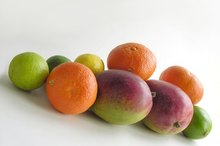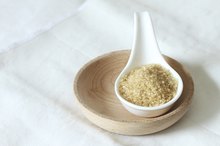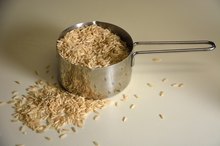What does fact checked mean?
At Healthfully, we strive to deliver objective content that is accurate and up-to-date. Our team periodically reviews articles in order to ensure content quality. The sources cited below consist of evidence from peer-reviewed journals, prominent medical organizations, academic associations, and government data.
The information contained on this site is for informational purposes only, and should not be used as a substitute for the advice of a professional health care provider. Please check with the appropriate physician regarding health questions and concerns. Although we strive to deliver accurate and up-to-date information, no guarantee to that effect is made.
Nutritional Facts on Cane Sugar
People have eaten sugar cane and used it as a sweetener for centuries. Colorado State University Extension notes that people are born with a liking for sweet foods and that an average person eats more than 100 lbs. of sugar in a year 3. Grown in tropical climates, including Hawaii and Louisiana, sugar cane is processed into a wide variety of sugars.
Tips
Cane Sugar has 375 Calories and 100.00 g of Carbohydrate, by difference per 100 gram serving according to the nutrition facts provided by the USDA Food Composition Database.
Types
White, granulated sugar is the most common type of cane sugar, but different types of sugar are easily available. Turbinado, or raw sugar, is made from the evaporation of sugar cane juice. It is not refined like white sugar. It has bigger crystals and a richer taste. Brown sugar still has some molasses content, which is a byproduct of producing white sugar. Confectioners, or powdered sugar, is merely white sugar which has been ground into a powder and mixed with a little cornstarch to prevent sticking. All varieties of cane sugar have the same nutritional content.
- White, granulated sugar is the most common type of cane sugar, but different types of sugar are easily available.
- Turbinado, or raw sugar, is made from the evaporation of sugar cane juice.
Calories
Is Sucanat Healthy?
Learn More
One teaspoon of granulated cane sugar contains 15 calories. All types of cane sugar, including raw sugar and brown sugar have the same amount of calories in each serving. There is no fat in sugar. MayoClinic.com, citing the American Heart Association, notes that women should only have 100 calories or less of added sugar per day, while men need to keep their added sugar intake to 150 calories or less per day. Added sugar does not include food sources of sugar, such as fruit.
- One teaspoon of granulated cane sugar contains 15 calories.
- All types of cane sugar, including raw sugar and brown sugar have the same amount of calories in each serving.
Nutritional Content
Sugar contains no nutrients other than simple carbohydrates. Each teaspoon of sugar contains 4 g carbohydrates. Your body uses sugar carbohydrates as energy. A serving of sugar provides 1 percent of the carbohydrates you need each day, but other food sources do a better job of providing the energy you need along with other nutrients. There is no sodium or protein in sugar.
- Sugar contains no nutrients other than simple carbohydrates.
Health
Cane vs. Beet Sugar Nutrition
Learn More
Adding too much sugar to your diet can lead to serious health issues. Tooth decay, heart disease, obesity and lower good cholesterol levels are just some of the problems that an over-consumption of sugar can cause. Sugar provides empty calories that fill you up without providing any essential nutrients, which might lead you to eat fewer healthy foods. It's essential to watch your sugar intake.
- Adding too much sugar to your diet can lead to serious health issues.
- Tooth decay, heart disease, obesity and lower good cholesterol levels are just some of the problems that an over-consumption of sugar can cause.
Tips
The problem with cutting back on your sugar intake is that so many processed foods contain it. You can easily reduce the amount of sugar you add to sweeten your drinks or use to bake with, but read food labels carefully. Condiments, such as salad dressing and ketchup, often have sugar in them. Keep in mind that women should consume 6 tsp. or less of sugar a day, and men should keep their consumption to 9 tsp. or less per day.
- The problem with cutting back on your sugar intake is that so many processed foods contain it.
- Keep in mind that women should consume 6 tsp.
Related Articles
References
- USDA Nutrient Data Laboratory: Sugars, Granulated
- MayoClinic.com: Added Sugar: Don't Get Sabotaged by Sweeteners
- What's Cooking America: Sugar -- Types of Sugar
- Sugars, granulated. USDA FoodData Central. Updated 12/16/2019
- Carbohydrates. Medline Plus. Updated March 13, 2020
- Food Availability and Consumption. United States Department of AgricultureEconomic Research Service. Updated February 28, 2020
- Know Your Limit for Added Sugars. Centers for Disease Control and Prevention. Updated April 3, 2019
- Wölnerhanssen BK, Meyer-gerspach AC. Health effects of sugar consumption and possible alternatives. Ther Umsch. 2019;76(3):111-116. doi:10.1024/0040-5930/a001070
- Delli Bovi AP, Di Michele L, Laino G, Vajro P. Obesity and obesity related diseases, sugar consumption and bad oral health: A fatal epidemic mixtures: The pediatric and odontologist point of view. Transl Med UniSa. 2017;16:11–16. Published 2017 Jul 1.
- Key Recommendations: Components of Healthy Eating Patterns. USDA. Dietary Guidelines 2015-2020
- The New and Improved Nutrition Facts Label – Key Changes. U.S. Food and Drug Administration. Updated March 2020
- Allergy/Intolerance to Sugar. American Academy of Allergy, Asthma, and Immunology. Updated 5/7/2019
- Sugar, granulated. FoodKeeper App. FoodSafety.gov Updated April 26, 2019
Writer Bio
Since 1997, Maria Christensen has written about business, history, food, culture and travel for diverse publications. She ran her own business writing employee handbooks and business process manuals for small businesses, authored a guidebook to Seattle, and works as an accountant for a software company. Christensen studied communications at the University of Washington and history at Armstrong Atlantic State University.









